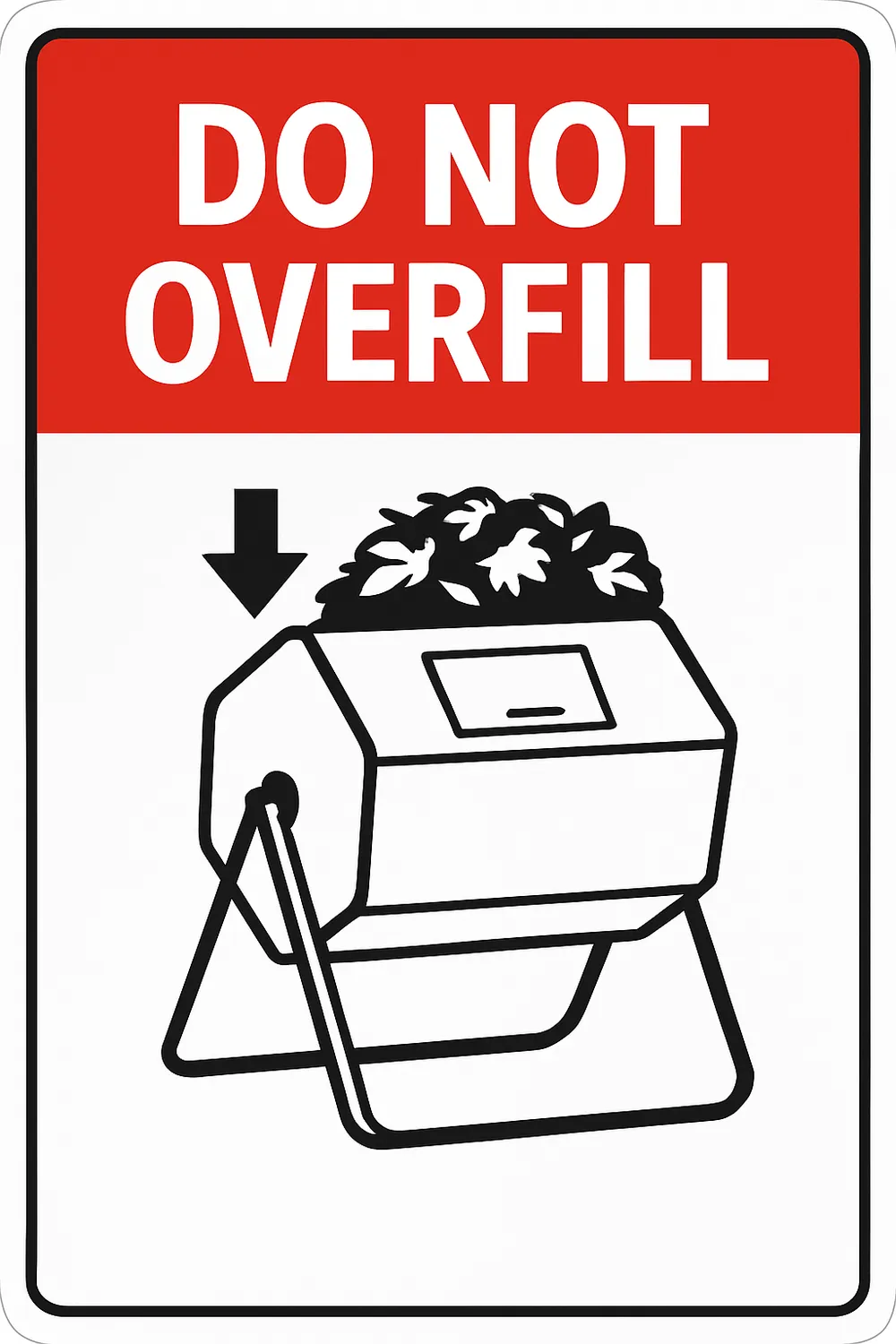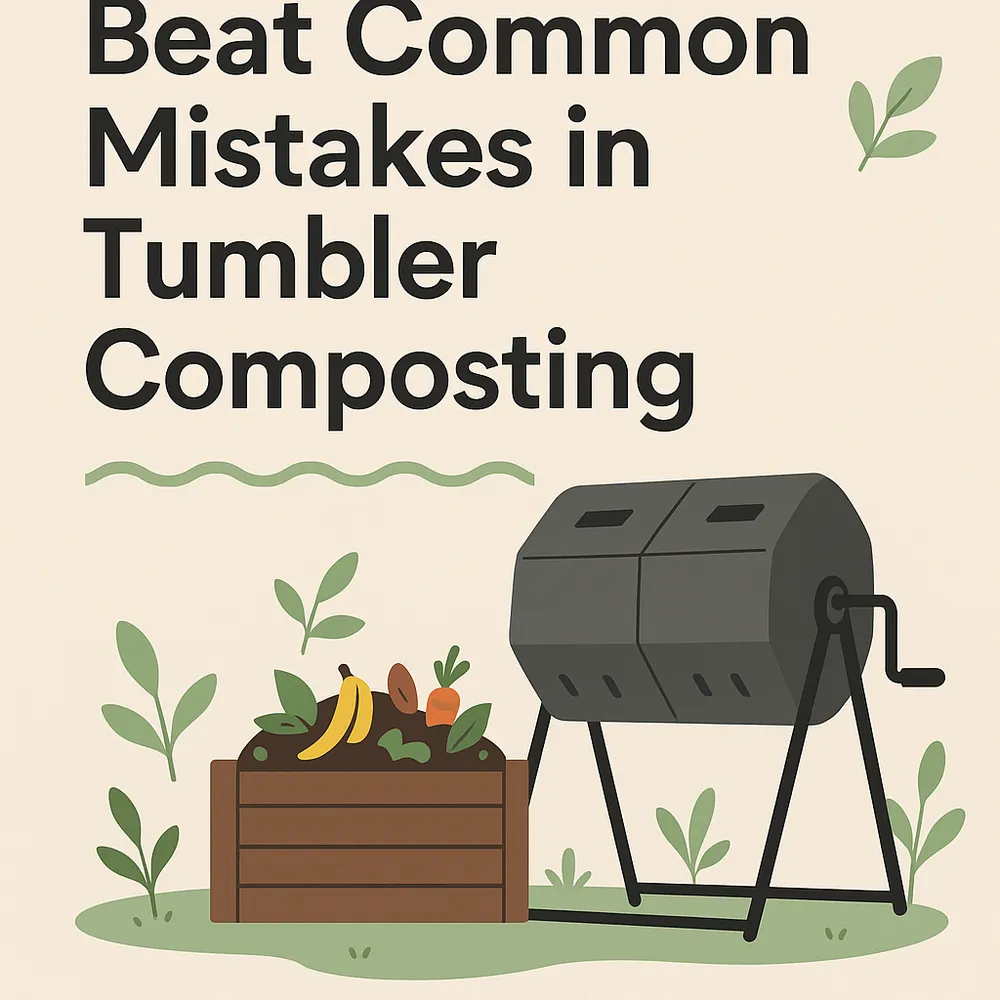Beat Common Mistakes in Tumbler Composting: Win Now!
Composting at home can be a rewarding experience, but it’s easy to fall into common mistakes, especially when using a compost tumbler. A good understanding, along with a few simple tricks, can make the difference between slow, smelly compost and nutrient-rich compost. This guide is designed to help you understand the nuances of tumbler composting and steer clear of composting mistakes.
Table of Contents
Understanding Composting in a Tumbler
What is a Compost Tumbler?
A compost tumbler is essentially a compost bin designed to rotate, and its main goal is to make the decomposition process easier by improving aeration. Instead of turning a compost pile manually, you can simply spin the tumbler. Compost tumblers come in various sizes, from small single-chamber models perfect for apartments to larger dual-chamber systems suitable for bigger backyards. Using a compost tumbler can really speed up the process if you get the balance right, helping you create a single chamber of rich compost. healthy compost in less time.
Benefits of Using a Compost Tumbler
The main benefit of using a compost tumbler is the ease with which you can provide aeration to your compost material. Regular turning, facilitated by the tumbler’s design, ensures that all parts of the compost pile receive oxygen, which is essential for the microbes responsible for decomposition. This not only speeds up the composting process but also helps to minimize unpleasant smells that can arise from anaerobic conditions in your home compost. Effective composting can be achieved without back-breaking work by using a composter. It’s also more pest-resistant than a traditional compost heap.
How a Tumbler Differs from Traditional Composting
Traditional composting involves creating a compost pile directly on the ground or in a stationary compost bin. The key difference lies in how aeration is achieved in the composter. In a traditional pile, you need to manually turn the compost with a pitchfork, which can be labor-intensive. A compost tumbler, on the other hand, allows for much easier and more frequent turning. This enhanced aeration can lead to faster decomposition and better control over moisture levels, reducing the likelihood of common composting mistakes. It’s just a more efficient composting system if you’re looking for speed.
Common Composting Mistakes to Avoid

Incorrect Material Balance
One of the most prevalent composting mistakes to avoid in tumbler composting revolves around achieving the correct material balance. The golden rule is to aim for a “brown to green” ratio of roughly 3:1. An imbalance can drastically slow down the decomposition speed, resulting in a smelly compost bin or a compost pile that simply refuses to break down. Remember, the compost needs both carbon and nitrogen for the microbes to thrive and do their job, and using a compost tumbler won’t help if this balance is off!
| Material Type | Examples |
|---|---|
| Browns (Carbon) | Dry leaves, shredded paper, cardboard |
| Greens (Nitrogen) | Grass clippings, food scraps, coffee grounds |
Ignoring Moisture Levels
Another common composting mistake is neglecting moisture levels. Compost should be damp, like a wrung-out sponge, not soggy or bone dry. Effective control is key.
| Moisture Level | Effect on Compost |
|---|---|
| Too Much Moisture | Anaerobic conditions, foul odors, hindering decomposition |
| Too Little Moisture | Microbes unable to break down material effectively |
If the compost is too wet, add more “browns” like shredded paper or dry leaves to absorb excess moisture. If it’s too dry, lightly water the compost pile as you turn the tumbler to speed up the process. Don’t be scared to regularly review your compost bin!
Improper Size of Food Scraps
The size of your food scraps matters more than you might think in tumbler composting. Large chunks of food scraps, like entire apples or big pieces of vegetable peelings, take significantly longer to decompose. This not only slows down the overall composting process but can also attract pests and flies. Before adding food scraps to your compost tumbler, chop them into smaller pieces to really speed up the composting process. Smaller pieces provide a larger surface area for microbes to attack, accelerating the decomposition process and contributing to successful composting and healthy compost. Remember this trick to ensure that you are not making a common mistake!
Common Mistakes in Tumbler Composting
Overloading the Tumbler
One of the most frequent common composting mistakes is overloading your compost tumbler. Filling the bin beyond its recommended capacity can significantly slow down the decomposition speed. Overcrowding reduces aeration, leading to anaerobic conditions and a smelly compost bin. The compost needs space to breathe and turn properly for effective decomposition. A guide to prevention To this alternative method, you can add an activator to enhance the process. mistake, is to fill only two-thirds of the composter. compost tumbler to ensure adequate airflow. This trick will improve the composting process, allowing the material to break down more efficiently and resulting in nutrient-rich compost. You’ll get healthy compost faster and without the foul odor.
Neglecting Aeration
Aeration is essential for composting in a tumbler, and neglecting it can be a common mistake. Microbes require oxygen to efficiently break down organic material. Without sufficient aeration, the compost pile becomes anaerobic, causing it to slow down the decomposition and produce foul odors. To avoid this composting mistake, regularly turn the tumbler as per the manufacturer’s instructions or more frequently. Turning ensures that all parts of the compost receive adequate oxygen, fostering decomposition. You can also add bulking agents like dry leaves or shredded cardboard to enhance airflow within the compost tumbler and speed up the process.
Failing to Monitor Temperature
Failing to monitor the temperature within your compost tumbler is another common composting mistake. Temperature is a key indicator of microbial activity, and effective control ensures optimal decomposition. Ideally, your compost pile should reach temperatures between 130°F to 160°F to kill harmful pathogens and weed seeds. To monitor temperature, use a compost thermometer and insert it into the center of the compost pile. If the temperature is too low, add more “greens” like grass clippings or coffee grounds to increase nitrogen levels and microbial activity. If it’s too high, add more “browns” like dry leaves or shredded paper to balance the carbon-nitrogen ratio. Monitoring can provide a solution to create finished compost more efficiently.
Tips for Successful Tumbler Composting
Choosing the Right Materials
To compost at home effectively, you should choose the right material. Successful tumbler composting hinges on the selection of appropriate material. As a guide, aim for a balanced mix of “greens” (nitrogen-rich) and “browns” (carbon-rich) to create a thriving compost pile. Greens include grass clippings, food scraps, and coffee grounds, while browns encompass dry leaves, shredded paper, and cardboard. Avoid adding meat, dairy, or oily food scraps, as they can attract unwanted pests in the winter. pests and cause unpleasant odors. Chop larger material into smaller pieces to speed up the composting process. This technique will ensure that your compost tumbler fosters rapid and effective decomposition, resulting in nutrient-rich compost.
Maintaining the Right Moisture Balance
Maintaining the right moisture balance is important for successful composting in a tumbler. The compost should be damp, like a wrung-out sponge. If the compost is too dry, the decomposition process will slow down significantly. Add water gradually while turning the tumbler to ensure even moisture distribution. If the compost is too wet, which is a common mistake, it can become anaerobic and smelly. To control excess moisture, add more “browns” like shredded paper or dry leaves to absorb the excess water. Regularly review the moisture levels and adjust accordingly to keep the composting process moving swiftly.
Regularly Turning the Compost
Regularly turning the compost is paramount for successful composting using a compost tumbler. Turning promotes aeration, ensuring that all parts of the compost pile receive oxygen. Using a compost tumbler A composter greatly simplifies this process, as you can simply rotate the chamber. bin instead of manually turning the compost heap. Aim to turn the tumbler at least every few days, or even daily if possible, to maintain optimal heating. aeration and speed up the decomposition process. Regular turning also helps to distribute moisture evenly throughout the compost, preventing dry pockets and promoting consistent microbial activity. Following this trick will lead to healthy compost.
Dealing with Pests and Odours
Identifying Common Pests
Dealing with pests in your compost tumbler can be a headache, but understanding the common culprits is the first step in prevention. Fruit flies are drawn to sweet food scraps, while rodents might be attracted to improperly composted meat or dairy. A common mistake is not burying food scraps deeply enough within the compost pile. By identifying these pests early, you can take proactive measures such as ensuring your compost bin is sealed properly. Using a compost tumbler helps with keeping pests out, but it is also important to bury food scraps in the center of the compost, which should control the problem.
Preventing Odours in Your Compost Tumbler
Smelly Odors emanating from your home compost can be minimized with proper aeration. compost tumbler often signal an imbalance in your compost pile. Anaerobic decomposition, caused by lack of aeration or excessive moisture, is a frequent cause. A simple solution is to ensure adequate aeration by regularly turning the tumbler. Adding more “browns” like dry leaves or shredded paper to absorb excess moisture can also help restore balance. This will speed up the composting process and allow you to maintain the right frequency for optimal composting. control the decomposition more effectively. If a compost bin is smelly, then it is often a sign that the composting process The composter is not working as it should.
Solutions for Common Issues
Troubleshooting common composting mistakes involves identifying the root cause of the problem. If your compost is too slow, check the material balance and moisture levels. Too much “greens” can lead to a smelly compost bin, while too little heating can lead to mould growth. moisture can halt decomposition. A guide to finding a solution To these issues is to adjust the “brown to green” ratio and ensure the frequency of aeration. compost is damp, like a wrung-out sponge. For persistent odors, review aeration practices, making sure you are regularly turning the tumbler. You might also want to ensure that the temperature is right to speed up the composting process.
Starting Your Composting Journey
How to Start Composting with a Tumbler
Composting at home with a tumbler can be straightforward. Position your compost tumbler in an accessible spot. To achieve healthy compost, use a combination of “browns” and “greens” in a specific ratio.
| Material Type | Examples |
|---|---|
| Greens | Grass clippings, food scraps |
| Browns | Dry leaves |
Remember to chop larger food scraps to speed up decomposition. The ideal moisture level for the material should resemble a wrung-out sponge. Turn the tumbler every few days to provide aeration and get ready for efficient composting.
Essential Tools for Tumbler Composting
While a compost tumbler is the core of your composting system, a few additional tools can enhance the composting process. A compost thermometer helps monitor internal temperatures, ensuring optimal microbial activity. A pitchfork or shovel is useful for collecting and transporting material to the bin. A watering can or hose assists in maintaining adequate moisture levels. Consider a small hand saw or chopper for breaking down larger “browns” and food scraps. With the right guide With these tools and a home compost setup, you’ll be well-equipped for effective composting. successful composting.
Monitoring Progress and Finished Compost
Tracking the decomposition within your compost tumbler is key to knowing when your compost is ready. Regularly inspect the material; it should gradually transform into a dark, crumbly substance with an earthy smell. Use a compost thermometer to monitor internal temperatures, ensuring they drop to ambient levels, as higher levels indicate activity is still underway. The material should also be significantly reduced in size, with identifiable food scraps no longer visible. Once these indicators align, your nutrient-rich compost is ready to enrich your garden.
Kaleem,
www.greenlifehub.com

